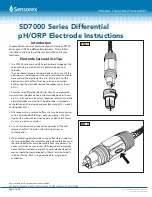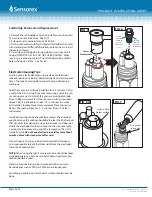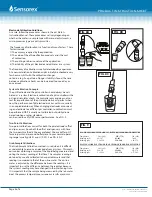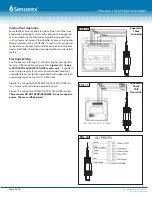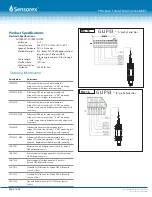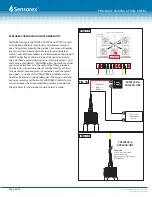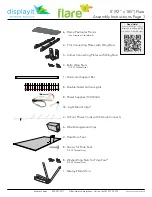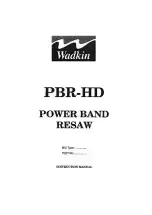
PRODUCT INSTRUCTION SHEET
Page 4 of 8
Form: InstrSD7000-05 [Rev: 2016-08-15]
©2016 Sensorex Corporation
Electrode Calibration Guidlines:
As a rule, follow the procedures shown in the pH Meter's
Instruction Manual. These procedures will vary depending on
whether the meter is a simple type with manual adjustments, a
micro-processor type or a pH transmitter.
The frequency of calibration is a function of many factors. These
factors include:
1) The accuracy required by the application.
2) The value of the off-specification product versus the cost
of calibration.
3) The coating or abrasive nature of the application.
4) The stability of the pH Electrode and pH Meter as a system.
The frequency of calibration is really determined by experience.
At a new installation, calibration might initially be checked every
few hours or shift with the calibration changes
noted in a log. As a pattern of longer stability is found, the time
between calibration checks can be increased to once a day or
once a week.
System Calibration Concepts
The pH Electrode and the pH controller should always be cali-
brated as a system. Electronic calibration of a pH controller with a
pH signal simulator checks the controller only and does not cor-
rect for imperfections of the pH electrode. Even if perfect when
new, the performance of pH electrodes varies with time, usually
in an unpredictable way. When changing electrodes or connect-
ing an electrode to a different pH controller, re-calibration must
be performed. ORP is usually not calibrated but quinhydrone
based solution or other standards
can be used to verify ORP sensor performance. See FIG. 9.
Two-Point Calibrations
Two-point calibrations correct for both the pH electrode's offset
and span errors. Since both the offset and span vary with time
the two-point method is the onr preferred. Choose buffer pH 7
for zero-point and a second buffer close to your normal operat-
ing range (usually pH4.01 or pH 10.00). See FIG. 8 A-C.
Grab Sample Calibrations
The Grab Sample Calibration method is used when it is difficult
or undesirable to remove an electrode from a system. This meth-
od involves obtaining a sample of the liquid being measured and
noting the meter's reading at that time. The sample's reading is
obtained by use of a calibrated lab or portable meter and that
reading is compared to that of the on-line meter. The on-line
meter is adjusted by the difference between the readings. It is
important to use the difference between the readings because
the system's reading may have changed in the intervening time.
It is important that the sample being measured by the lab meter
be at the process temperature or erroneous results may occur.
pH
4.0
1
BU
FFE
R
pH 4.01
BUFFER
pH Meter
7.00pH
pH 4.01/10.00
pH 7.00
FIG. 8A
FIG. 8B
FIG. 8C
PLATINUM ORP ELECTRODE IN 7 BUFFER/QUINHYDRONE MIXTURE
Temperature
20C (68F)
25C (77F)
30C (86F)
Readings (mV)
89-107
83-101
76-94
Readings (pH)
5.20-5.50
5.30-5.60
5.42-5.72
PLATINUM ORP ELECTRODE IN 4 BUFFER/QUINHYDRONE MIXTURE
Temperature
20C (68F)
25C (77F)
30C (86F)
Readings (mV)
260-287
254-281
247-274
Readings (pH)
2.15-2.60
2.25-2.70
2.37-2.82
FIG. 9

